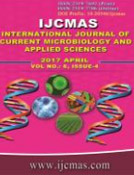


 National Academy of Agricultural Sciences (NAAS)
National Academy of Agricultural Sciences (NAAS)

|
PRINT ISSN : 2319-7692
Online ISSN : 2319-7706 Issues : 12 per year Publisher : Excellent Publishers Email : editorijcmas@gmail.com / submit@ijcmas.com Editor-in-chief: Dr.M.Prakash Index Copernicus ICV 2018: 95.39 NAAS RATING 2020: 5.38 |
Polycyclic aromatic hydrocarbons (PAHs) are an important group of organic pollutants. They are ubiquitous environmental pollutants generated primarily during the incomplete combustion of organic materials (e.g. coal, oil, petrol, and wood). Emissions from anthropogenic activities are highly responsible for their generation. The demand for processed petroleum products and agricultural produce has exposed our environment to PAH contamination. Globally, the combustion of fossil fuels and wildfires are major sources of PAHs, while road traffic and specific industries frequently dominate urban emissions. The majority of Earth’s hydrocarbon resource is only partially degraded. Bioremediation processes by microorganisms including bacteria, fungi and algae and also phytoremediation are the promising methods in cleaning up PAHs from the environment. These clean-up methods are not only environmental friendly but also present a novel approach in reducing the PAHs ability of causing risk to humans and to the ecosystem. Finally, summarise this review, as the sources of PAHs, their fate of transport, bioaccumulation, toxicity and the bacterial biodegradation aspects of both low molecular weight and high molecular weight PAHs.
 |
 |
 |
 |
 |